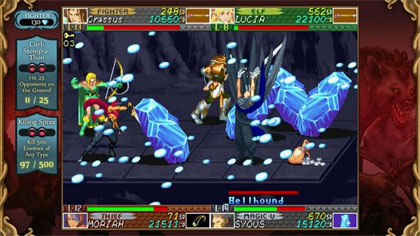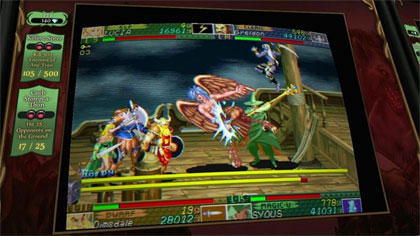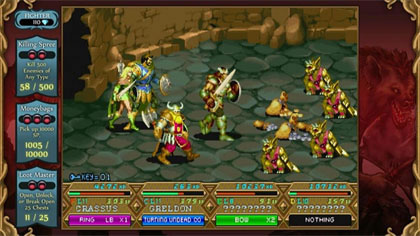- CLASSIC MAGAZINES
- REVIEW CREW
A show recapping what critics thought back
when classic games first came out! - NEXT GENERATION'S BEST & WORST
From the worst 1-star reviews to the best
5-stars can offer, this is Next Generation! - NINTENDO POWER (ARCHIVE)
Experience a variety of shows looking at the
often baffling history of Nintendo Power! - MAGAZINE RETROSPECTIVE
We're looking at the absolutely true history of
some of the most iconic game magazines ever! - SUPER PLAY'S TOP 600
The longest and most ambitious Super NES
countdown on the internet! - THEY SAID WHAT?
Debunking predictions and gossip found
in classic video game magazines! - NEXT GENERATION UNCOVERED
Cyril is back in this spin-off series, featuring the
cover critic review the art of Next Generation! - HARDCORE GAMER MAGAZING (PDF ISSUES)
Download all 36 issues of Hardcore Gamer
Magazine and relive the fun in PDF form!
- REVIEW CREW
- ELECTRONIC GAMING MONTHLY
- ELECTRONIC GAMING MONTHLY RANKS
From Mario to Sonic to Street Fighter, EGM
ranks classic game franchises and consoles! - ELECTRONIC GAMING MONTHLY BEST & WORST
Counting down EGM’s best and worst reviews
going year by year, from 1989 – 2009! - ELECTRONIC GAMING BEST & WORST AWARDS
11-part video series chronicling the ups and
downs of EGM’s Best & Worst Awards!
- ELECTRONIC GAMING MONTHLY RANKS
- GAME HISTORY
- GAME OVER: STORY BREAKDOWNS
Long-running series breaking down game
stories and analyzing their endings! - A BRIEF HISTORY OF GAMING w/ [NAME HERE]
Real history presented in a fun and pithy
format from a variety of game historians! - THE BLACK SHEEP
A series looking back at the black sheep
entries in popular game franchises! - INSTANT EXPERT
Everything you could possibly want to know
about a wide variety of gaming topics! - FREEZE FRAME
When something familiar happens in the games
industry, we're there to take a picture! - I'VE GOT YOUR NUMBER
Learn real video game history through a series
of number-themed episodes, starting at zero! - GREAT MOMENTS IN BAD ACTING
A joyous celebration of some of gaming's
absolute worst voice acting!
- GAME OVER: STORY BREAKDOWNS
- POPULAR SHOWS
- DG NEWS w/ LORNE RISELEY
Newsman Lorne Riseley hosts a regular
series looking at the hottest gaming news! - REVIEW REWIND
Cyril replays a game he reviewed 10+ years
ago to see if he got it right or wrong! - ON-RUNNING FEUDS
Defunct Games' longest-running show, with
editorials, observations and other fun oddities! - DEFUNCT GAMES QUIZ (ARCHIVE)
From online quizzes to game shows, we're
putting your video game knowledge to the test!- QUIZ: ONLINE PASS
Take a weekly quiz to see how well you know
the news and current gaming events! - QUIZ: KNOW THE GAME
One-on-one quiz show where contestants
find out if they actually know classic games! - QUIZ: THE LEADERBOARD
Can you guess the game based on the classic
review? Find out with The Leaderboard!
- QUIZ: ONLINE PASS
- DEFUNCT GAMES VS.
Cyril and the Defunct Games staff isn't afraid
to choose their favorite games and more! - CYRIL READS WORLDS OF POWER
Defunct Games recreates classic game
novelizations through the audio book format!
- DG NEWS w/ LORNE RISELEY
- COMEDY
- GAME EXPECTANCY
How long will your favorite hero live? We crunch
the numbers in this series about dying! - VIDEO GAME ADVICE
Famous game characters answer real personal
advice questions with a humorous slant! - FAKE GAMES: GUERILLA SCRAPBOOK
A long-running series about fake games and
the people who love them (covers included)! - WORST GAME EVER
A contest that attempts to create the worst
video game ever made, complete with covers! - LEVEL 1 STORIES
Literature based on the first stages of some
of your favorite classic video games! - THE COVER CRITIC
One of Defunct Games' earliest shows, Cover
Critic digs up some of the worst box art ever! - COMMERCIAL BREAK
Take a trip through some of the best and
worst video game advertisements of all time! - COMIC BOOK MODS
You've never seen comics like this before.
A curious mix of rewritten video game comics!
- GAME EXPECTANCY
- SERIES ARCHIVE
- NINTENDO SWITCH ONLINE ARCHIVE
A regularly-updated list of every Nintendo
Switch Online release, plus links to review! - PLAYSTATION PLUS CLASSIC ARCHIVE
A comprehensive list of every PlayStation
Plus classic release, including links! - RETRO-BIT PUBLISHING ARCHIVE
A regularly-updated list of every Retro-Bit
game released! - REVIEW MARATHONS w/ ADAM WALLACE
Join critic Adam Wallace as he takes us on a
classic review marathon with different themes!- DEFUNCT GAMES GOLF CLUB
Adam Wallace takes to the links to slice his way
through 72 classic golf game reviews! - 007 IN PIXELS
Adam Wallace takes on the world's greatest spy
as he reviews 15 weeks of James Bond games! - A SALUTE TO VAMPIRES
Adam Wallace is sinking his teeth into a series
covering Castlevania, BloodRayne and more! - CAPCOM'S CURSE
Adam Wallace is celebrating 13 days of Halloween
with a line-up of Capcom's scariest games! - THE FALL OF SUPERMAN
Adam Wallace is a man of steel for playing
some of the absolute worst Superman games! - THE 31 GAMES OF HALLOWEEN
Adam Wallace spends every day of October afraid
as he reviews some of the scariest games ever! - 12 WEEKS OF STAR TREK
Adam Wallace boldly goes where no critic has
gone before in this Star Trek marathon!
- DEFUNCT GAMES GOLF CLUB
- DAYS OF CHRISTMAS (ARCHIVE)
Annual holiday series with themed-episodes
that date all the way back to 2001!- 2015: 30 Ridiculous Retro Rumors
- 2014: 29 Magazines of Christmas
- 2013: 29 Questionable Power-Ups of Christmas
- 2012: 34 Theme Songs of Christmas
- 2011: 32 Game Endings of Christmas
- 2010: 31 Bonus Levels of Christmas
- 2009: 30 Genres of Christmas
- 2008: 29 Controls of Christmas
- 2007: 34 Cliches of Christmas
- 2006: 33 Consoles of Christmas
- 2005: 32 Articles of Christmas
- 2004: 31 Websites of Christmas
- 2003: 29 Issues of Christmas
- 2002: 28 Years of Christmas
- 2001: 33 Days of Christmas
- NINTENDO SWITCH ONLINE ARCHIVE
- REVIEW ARCHIVE
- FULL ARCHIVE
Dungeons & Dragons: Chronicles of Mystara
For many people, arcade brawlers are little more than repetitive stages with simplistic gameplay. Even agreed upon classics, like Double Dragon and Final Fight, are just lengthy exercises in button mashing. And between X-Men, Teenage Mutant Ninja Turtles and The Simpsons, Xbox Live Arcade gamers have been inundated with these mind-numbingly basic brawlers. It's easy to understand why some people are so put off by this old school genre.
But no matter how sick and tired you are of button mashing your way through linear stages, I'm here to tell you that Dungeons & Dragons: Chronicles of Mystara is different. Released in the mid-1990s, the two games featured in Capcom's newest arcade compilation are on a whole other level than the brainless brawlers you're used to. And best of all, this is the first time either of these Dungeons & Dragons games have been released on a North American game console.

Both 1994's Tower of Doom and its sequel, Shadow Over Mystara from 1996, attempt to cram a full Dungeons & Dragons experience into an hour-long action/adventure game. Don't let the fact that it was an old arcade game fool you, what lies beneath is a deep and involving journey full of twists and turns. And instead of simply being along for the ride, the players actually have some input on how the story unfolds.
Right from the start, we're given a choice between a number of high fantasy stereotypes, such as a dwarf, thief, fighter, elf and magician. These characters not only look radically different, but they also have their own types of weapons, special moves and abilities. The fighter specializes in powerful sword-based combat, while the magician can stay back and cast spells on the enemy. These characters complement each other, allowing four players to come together and become an unstoppable fighting force.
Both games take you through the kinds of levels you expect to see in this type of fantasy brawler. Your fellowship will fight through deadly swamps, on an airship, in the forest, past giant castles, and yes, you'll even encounter a dungeon or two. Not only is there a giant boss to contend with in each of these stages, but there are also a number of secret rooms and extra paths to take along the way. Both Tower of Doom and Shadow Over Mystara reward players to exploring every inch of world.

Choosing your own narrative is a big deal in both of Capcom's Dungeons & Dragons brawlers. Often times it's an obvious choice, allowing the player to customize the adventure they want to embark on. However, there are a few moments where you will make moral choices. Do you want to save the village under attack, or are you the heartless jerk who will ignore their cries and continue on your way to the Red Dragon? The choice is up to you, and whatever you choose will change the levels you play going forward.
By giving the player so many different paths to choose from, Dungeons & Dragons: Chronicles of Mystara requires multiple play-throughs in order to see and do everything. That's good news, considering that most arcade brawlers are exactly the same every time. And because the characters are so different, playing a different class makes the game feel fresh all over again. With so many different paths and characters, you'll definitely get your money's worth with Capcom's newest compilation.
While both games are similar in approach, there are some striking differences between Tower of Doom and Shadow Over Mystara. The 1994 installment locks you to one character from start to finish, while the sequel allows swapping with each continue. You'll also discover that one game looks substantially better than the other. The 1996 sequel features level that are teaming with small details, while Tower of Doom looks flat and boring in comparison. Perhaps the biggest difference is how each game manages the inventory. It's clear that Capcom learned its lessons from the first game, giving players a much more user-friendly second chapter.
But while so much of these games is different, you'll also see a lot of similarities. Both games take place in the same universe, so expect to see the same sorts of landscapes and enemies. Even a couple bosses are repeated from one game to the next. Thankfully most of the repeated elements are masked with an impressive set-piece or some other eye-catching effect.

Much like Marvel vs. Capcom Origins and DarkStalkers Resurrection, this Dungeons & Dragons compilation features a bunch of challenges to complete. All across the left side of the screen are stats that are constantly being updated, including how many characters you kill and magic spells you use. You'll earn coins for every milestone you hit, which allows the player to open up a bunch of extras. You'll ultimately earn exclusive music tracks, early artwork and even a few modes that let you tweak with the game's difficulty. By now this is a common feature in Capcom's arcade collections, but even so, this is a good idea that adds yet more incentive to play through the games multiple times.
On top of the challenges to complete, Dungeons & Dragons: Chronicles of Mystara comes with a bunch of video options. The game defaults to an ugly filtered look, which tries to mask some of the arcade game's imperfections. But don't worry, that filter can be removed completely. And it doesn't stop there. You can add scan lines to better approximate the arcade cabinet as well as change how the camera is looking at the screen. A lot of the choices run from silly to novelty, but I like that Capcom continues to include these outlandish options.

Even beyond the added extras and online multiplayer mode, the real reason to be excited about these brawlers is because they are incredibly rare. Neither game saw much action in American arcades, and the only console ports were confined to the Japanese Sega Saturn. With the exception of MAME, there has been no way to play either of these classic brawlers in the United States.
Dungeons & Dragons: Chronicles of Mystara took its time to hit the United States, but I'm happy to report that it was worth the wait. This is more than just another brawler full of mindless button mashing and linear stages, it's a deep role-playing experience that is complete with leveling up, equipping new items and perfecting magic spells. With multiple paths and plenty of unique characters to play, there's definitely a lot of reason to play these Dungeons & Dragons games multiple times. Chronicles of Mystara is everything the Golden Axe trilogy wished it could be.
HOME |
CONTACT |
NOW HIRING |
WHAT IS DEFUNCT GAMES? |
NINTENDO SWITCH ONLINE |
RETRO-BIT PUBLISHING
Retro-Bit |
Switch Planet |
The Halcyon Show |
Same Name, Different Game |
Dragnix |
Press the Buttons
Game Zone Online | Hardcore Gamer | The Dreamcast Junkyard | Video Game Blogger
Dr Strife | Games For Lunch | Mondo Cool Cast | Boxed Pixels | Sega CD Universe | Gaming Trend
Game Zone Online | Hardcore Gamer | The Dreamcast Junkyard | Video Game Blogger
Dr Strife | Games For Lunch | Mondo Cool Cast | Boxed Pixels | Sega CD Universe | Gaming Trend
Copyright © 2001-2025 Defunct Games
All rights reserved. All trademarks are properties of their respective owners.
All rights reserved. All trademarks are properties of their respective owners.





























